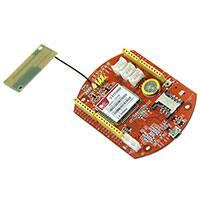Arch GPRS V2
Arch GPRS V2 is the new and improved version of the Arch GPRS development board from Seeed Studio. Like the original Arch GPRS, it is
also an mbed enabled development board that houses a cellular networking module along with a microcontroller. Arch GPRS V2 uses the
LPC11U37 Microcontroller instead of the LPC11U24 used in the Arch GPRS. You can use the mbed C/C++ SDK, libraries and optimizing
online development tools to rapidly build your Arch GPRS V2 based prototype. The cellular networking module on the Arch GPRS is based
on the SIM900 Quad-band GSM/GRPS engine from SIMCom. With this, data collection functions can be performed easily using the 2G
GSM/GPRS based cellular network. Arch GPRS V2 has a standard Arduino interface as well as Grove connectors on board. It is convenient
to connect existing Shields and Grove products to Arch GPRS V2. You can even connect a solar panel directly to the board to allow the
battery to charge from it. A low-power design guarantees easy charging and long hour operations when outdoors!
Note
Arch GPRS V2 does not come with an mbed interface. To output debug messages, please try USBSerial.
Features
o
o
o
o
o
o
o
o
o
mbed enabled
Online development tools
Easy to use C/C++ SDK
Lots of published libraries, projects
NXP LPC11U37 Controller
Low power ARM Cortex-M0 Core
On chip 128KB Flash, 12KB SRAM, 4KB EEPROM
USB Device, UART, I2C
SIM900 Module
Quad-band (850/900/1800/1900MHz) GSM/GPRS support
Supports external SIM card: 1.8V/3V
Control with standard AT Commands
Select automatically USB5V or Solar panel to charge a battery
�Arch GPRS V2 vs Arch GPRS
Parameter
Arch GPRS V2
Arch GPRS
MCU
LPC11U27
LPC11U24
GSM/GPRS Module
SIM900
EG-10
MicroSD Card
Yes
No
Hardware Overview
�Getting Started
1.
2.
3.
4.
5.
Login into the mbed environment from here
Import the mbed_blinky program
Verify that the code imported in main.cpp in the mbed_blinky folder in the mbed online Compiler environment is as indicated in the
figure above under Step 3. Ensure that the platform selected for compiling the code for is the Seeeduino-Arch. Now go ahead and
compile the code. When asked to save the resultant binary file (.bin), save it to a designated folder on your PC.
Now connect your Arch board to your PC and long press the reset button. A removable USB drive named CRP DISABLD should
automatically appear on your PC. Go to the CRP DISABLD drive, delete the existing firmware file that you see in the folder and
copy the downloaded binary file to CRP DISABLD. Quick press the reset button to run the new binary.
Verify that your code is running successfully by looking at the Arch GPRS V2 board. If the right-most LED from the Pinout shown
above is blinking and the other 3 LEDs next to it are all ON, this implies that your code is working.
You can change the code to the following and see what happens:
1
#include "mbed.h"
2
3
DigitalOut myled1(LED2); //left most LED if board is held as shown in
4 Pinout diagram above
5
DigitalOut myled2(LED3); //2nd from left
6
DigitalOut myled3(LED4); //3rd from left
7
DigitalOut myled4(LED1); //4th from left (right most)
8
9
int main() {
10
while(1) {
11
12
myled1 = 1; //left most LED turns ON, rest off
13
myled2 = 0;
14
myled3 = 0;
15
myled4 = 0;
16
17
wait(1); //1 sec wait time
18
myled1 = 0;
19
myled2 = 1; //2nd from left LED turns ON, rest off
20
myled3 = 0;
21
myled4 = 0;
22
23
wait(1);
24
myled1 = 0;
25
myled2 = 0;
26
myled3 = 1; //3rd from left LED turns ON, rest off
27
myled4 = 0;
�28
29
30
31
32
33
34
35
36
wait(1);
myled1 =
myled2 =
myled3 =
myled4 =
0;
0;
0;
1; //4th from left (right most) LED turns ON, rest off
wait(1);
}
}
When you Compile and Run the above code on the Arch GPRS V2 board, you should see that the LEDs blink in sequence.
If you get through the above steps successfully, this means that:
1.
2.
3.
Your Arch GPRS V2 is powering up correctly.
Your code is being downloaded and run by the Arch GPRS V2 module correctly.
You are ready to take on more complex projects now!
Programming Arch on Windows, Linux or Mac
Arch does not have an mbed interface. It uses USB In-System-Programming (ISP) to upgrade the firmware.
To enter the USB ISP mode, connect the Arch with your computer and long press its button, and then a disk named "CRP DISABLD" will
appear.
On windows
1.
delete firmware.bin in the "CRP DISABLD" disk.
2.
copy a new firmware into the disk.
On linux
1.
2.
if the disk is not mounted, mount the disk at {mnt_dir}
dd if={new_firmware.bin} of={mnt_dir}/firmware.bin conv=notrunc
On mac you'll need to use Terminal to run the following script to copy you're .bin file to your Arch
1.
dd if={new_firmare.bin} of=/Volumes/CRP\ DISABLD/firmware.bin conv=notrunc
If you are so inclined, you can also create an Automator application to support drag-and-drop of the file to your board. Just create a "Run
Shell Script" with the following command:
dd if=$* of=/Volumes/CRP\ DISABLD/firmware.bin conv=notrunc
You will also need to change the "Pass
Input" option from "to stdin" to "as arguments"--without this you will get
action 'Run Shell Script' encountered an error" or "dd: no value
specified for if (1)" in the log.
an error "The
Also, an improved form of the script is: dd if="${1}" of=/Volumes/CRP DISABLD/firmware.bin conv=notrunc
Which should handle spaces in the file path and only uses the first file supplied. Quick press the button to run the new firmware.
Tech Support
Please submit any technical issue into our forum or drop mail to techsupport@seeed.cc.
http://wiki.seeedstudio.com/Arch_GPRS_V2/2‐28‐19
�
很抱歉,暂时无法提供与“113010001”相匹配的价格&库存,您可以联系我们找货
免费人工找货